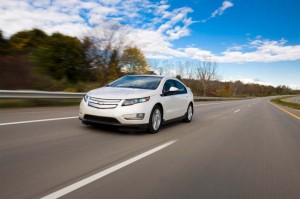
GM may have found a partner that could double the range of battery-based vehicles like the Chevrolet Volt.
Perhaps the single biggest problem with electric vehicles is the limited range of today’s batteries. But General Motors is betting that a small California company may have a breakthrough that could substantially increase so-called energy density yielding a major increase in the distance battery cars can travel between charges.
The automaker’s investment arm, GM Ventures LLC, is investing heavily in Envia Systems, based in Newark, California. The firm claims to have developed a new way to pack about 400 watt hours of energy into a kilogram of battery. Put into perspective, that’s a full ten times as much “juice” as the nickel-metal hydride battery in a Toyota Prius can hold and as much as twice the energy even the best of today’s advanced lithium-ion batteries can manage.
That would potentially permit a Chevrolet Volt plug-in hybrid to go 70 miles on a charge, for example, compared to 35 today. And pure battery-electric vehicles such as the Nissan Leaf or Ford Focus Electric, could deliver range closer to what a gas-powered vehicle might yield on a tank of petrol, rather than the 70 to 100 miles they can eke out today.
“I think we’ve got better than a 50-50 chance to develop a car that will go to 200 miles on a charge,” says GM CEO Dan Akerson, who calls Envia’s technology a potential “game-changer.”
What’s equally significant about the Envia technology is that the company believes it can drive up range while driving down costs. The Volt carries a significant price premium for its 16 kilowatt-hours of battery, a factor that analysts say is seriously limiting sales.
As recently as four years ago, manufacturers were paying about $1,000 a kilowatt-hour for lithium batteries, a hefty bill considering the size of the pack needed to go even short distances, and a major drawback for longer ranges. Tesla, for example, is offering a 300-mile battery pack for its new Model S, but that option can push the sedan to more than $100,000, or about double the base price.
Industry analysts have been anticipating prices would fall as lithium technology goes into widespread production, Nissan expecting to see the batteries in its Leaf dip to perhaps $400 by the end of that vehicle’s life. But Envia has said it is targeting a $125 per kilowatt-hour price tag. At that figure, the price of a battery car would be comparable to that of a similar gas-powered model, according to various analysts.
Akerson discussed the potential for the Envia investment during a conference call with employees during which he also discussed the recent turmoil surrounding the company – and during which he called on GM staff to stop leaking inside information.
(Akerson says employees leaking data are committing “treason.” For more on that story, Click Here.)
When an employee asked about the Envia investment, Akerson said, “These little companies come out of nowhere, and they surprise you.”
Earlier this week, the automaker announced it was making another investment through GM Ventures into the East Coast start-up NanoSteel. The firm claims to have a new approach that can yield markedly stronger and lighter versions of steel. That could prove to be a cost-effective alternative to more advanced – and expensive – materials, such as aluminum and carbon fiber.
GM, like its competitors, needs to slash the weight of its vehicles to improve their fuel economy. Weight savings can prove particularly helpful in improving the range of an electric vehicle, as well. So, taken together, the maker is hoping the NanoSteel and Envia investments could give it a big advantage over competitors using more conventional technologies.

This is what I’ve been telling naysayers for a while now. Give it time, prices will come down and batteries will get better. I remind them of the first VCR’s that came out. They were $20,000.00 each. Now if you can find one you can get it for around $25.00. Same with flat screen TV’s.
Be cautious before you anticipate the company’s technology will actually ever get into the real world. We received a note, in fact, from the CEO cautioning that they have not yet laid out specifics on the benefits, costs, etc. But improvements to battery technology are likely. The question is how soon and how much?
Paul E.
Battery-based vehicles are becoming an option for many car buyers out there. Technologies, like the battery Envia is developing, are only going to make this genre of car more appealing (and accessible) for the public.
http://www.oconnorwheels.com/